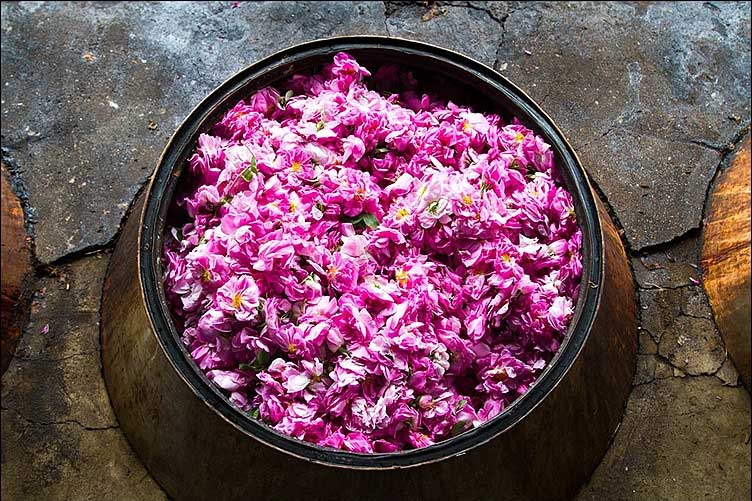The dry central desert of Iran has hidden pink-colored gems in its depth and the spectator eyes are dazzled at the rubies. Every year during the second half of May, an ancient festival is being held in Kashan and surrounding areas where many people from different parts of the country and abroad are gathered to see flower-picking and process of extracting rosewater as well as historic monuments and architecture. Over 2,000 Kashani inhabitants are involved in the cultivation, growing and picking roses and the production of rosewater whose major activity is centered at the Karkas Mountain slopes and the west of Kashan. The cultivated lands are estimated by the experts at 850 hectares and on the average three tons of rose are harvested at each hectare.
The flowers should be picked before sunrise to preserve their fragrance and members of each family specially women set out to rose gardens once they are through with their morning prayers and addressing their appreciation to the Lord for his blessings. The sight of women with rose-filled baskets under their arms is quite interesting. The season for picking rose and preparing rosewater is from early May to mid-June. In early May, the scent of rose spreads over different areas of Kashan, such as Ghamsar, Barzak and Niasar.
Ghamsar rosewater
Ghamsar is like a shining star on the central Iranian desert; surrounding mountains encircle it like a ring and protect its rose gardens against the heat of the desert. It is the breeding ground for the finest and the most exquisite Mohammadi flowers and has the best traditions and methods for production of rosewater. It is also the first place where industrial production of rosewater has begun and there are many workshops in the city which produce rosewater. The environment of this garden city, the shade of trees and sound of flowing water in addition to music of birds and nightingales and fragrance of roses, has created an incredible milieu on the side of the desert.
Ghamsar looks like paradise when becomes colorful as the spring begins and rose water ceremony commences. Its hospitable people collect roses, boil them in special pots and collect their water in beautiful containers. It is a pride for the city that each year, the most sacred place on earth, the Kaaba in Mecca, is washed with rosewater from Ghamsar. Although production of plant essences has a long history in Iran, but traditional rose water production machines were used to produce rose water for commercial purposes. Before that, rosewater was produced through small distillation equipment for local uses. Anyway, production of rosewater has been in vogue since ancient times and has sometimes led to prosperity of copper, glass making and packaging industries. Most of the local product is exported to other parts of the country and, therefore, despite most handicrafts, it has held its ground in contemporary times and has constantly improved in terms of quality and quantity.
Another outcome of that situation was spread of the industry to neighboring villages of Ghamsar and even to other provinces during past decades. The emphasis put on Ghamsar is due to high quality of its rosewater which results from natural conditions of the city. The city has been and still is the main production center for the highest quality rosewater as a result of its natural and climatic conditions. According to a study carried out by professors of Tehran University, the essence of Mohammadi flower of Ghamsar and the subsequent rosewater has a concentration of 35 mg per 100 ml or 350 ppm, which makes it the finest and highest quality rose water in Iran and even in the world.
Medical purposes
The Iranian red flower or Mohammadi flower is unique and most botanists have opined that it has been first planted in Iran and then taken to other countries. Due to containing tannin, Gallic acid, essence, fatty acids, pigments and ascorbic acid (vitamin C), petals of Mohammadi flower are used not only for production of rosewater and essence, but for production of rose petal jam.
Since a long time ago, this plant was used in traditional medicine to treat various diseases including chronic diarrhea, rheumatic pains, blood abnormalities, and sore throat. The part of the flower, which is used to produce rose water and essence, is petals. Boiled petals of Mohammadi flower are alkaline and constitute a good remedy for stress, flatulence, and abdominal colic. The boiled petals are also used to fight depression and to treat palpitation, insomnia, ordinary and bloody diarrhea, sickness, and inflammation. In the past, rose water was used in traditional Iranian medicine to treat rheumatic heart disease, to strengthen gastric nerves, and to treat some forms of headache and sickness.





